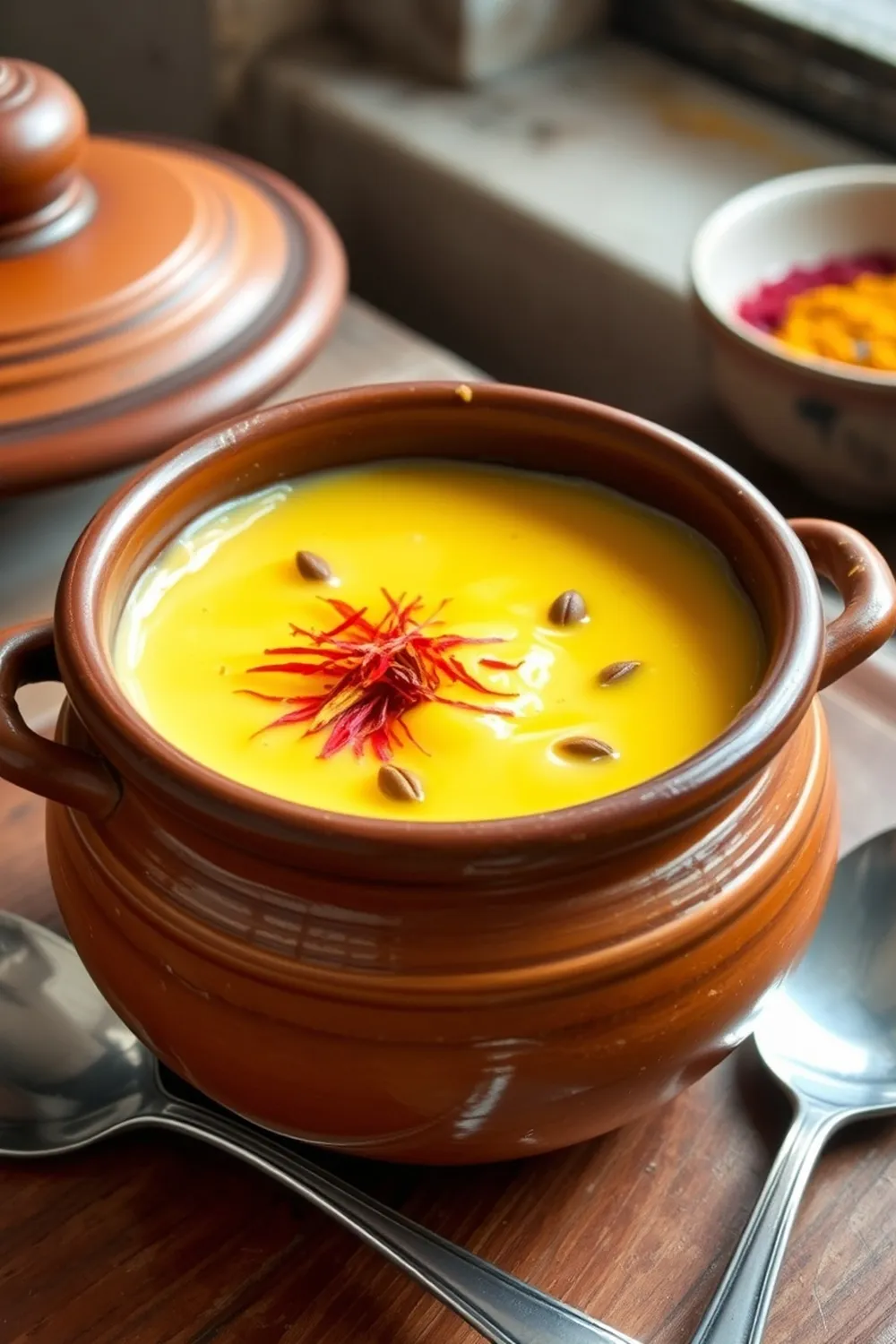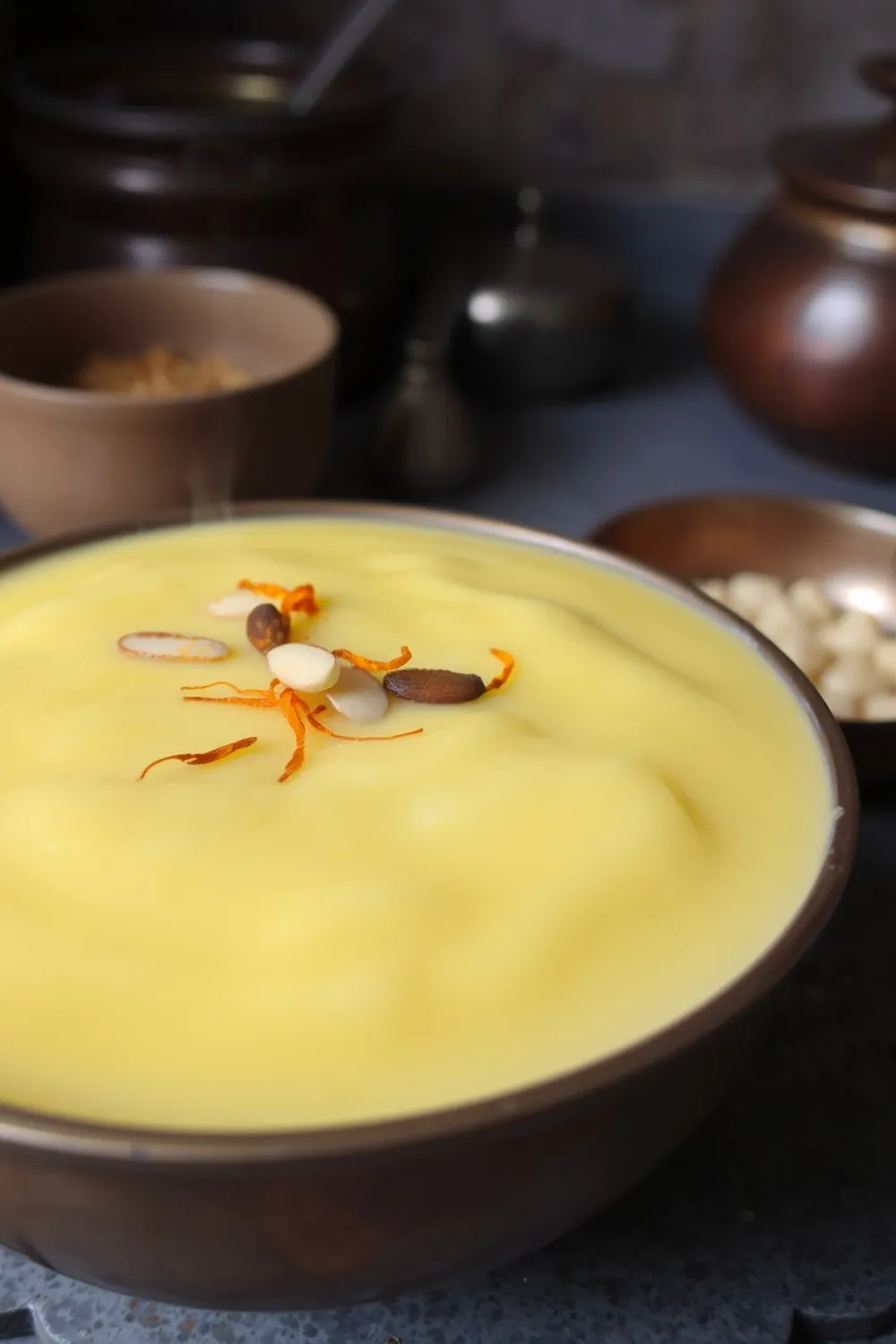- Heat 1 tsp ghee in a pan. Add rice and roast until lightly golden and fragrant. Grind coarsely, being careful not to form a powder.
- Boil milk in a pressure cooker. Add a spoon or plate to prevent sticking/burning. Stir in the roasted rice once the milk comes to a boil.
- Pressure cook on low heat for 2-3 whistles. Allow the steam to release naturally. Open the cooker, stir well, and simmer. Add sugar and cardamom powder. Cook until the payasam reaches a slightly thickened consistency.
- In a separate pan, roast cashews in the remaining ghee until golden brown. Mix the roasted cashews into the payasam. Serve warm or chilled.
- Calories:360 kcal25%
- Energy:1506 kJ22%
- Protein:6 g28%
- Carbohydrates:33 mg40%
- Sugar:30 mg8%
- Salt:100 g25%
- Fat:12 g20%
Last Updated on 4 months by Neha Deshmukh
Basmati Rice Payasam Recipe – Traditional Indian Rice Pudding with Cashews
Hey everyone! If you’re looking for a dessert that’s comforting, subtly sweet, and feels like a warm hug, you have to try this Basmati Rice Payasam. It’s a classic Indian rice pudding, and honestly, it’s one of those recipes I keep coming back to, especially during festivals or when I just need a little something sweet to brighten my day. I first made this for Diwali a few years ago, and it’s been a family favorite ever since!
Why You’ll Love This Recipe
This payasam is special for a few reasons. It’s incredibly easy to make – seriously, even if you’re new to Indian cooking, you can nail this. The aroma of cardamom and ghee is just heavenly, and the creamy texture is unbelievably satisfying. Plus, it’s a wonderful way to use up leftover basmati rice! It’s a simple dessert that delivers big on flavor and comfort.
Ingredients
Here’s what you’ll need to make this delicious payasam:
- 2 cups Milk (approximately 475ml)
- 2 tbsp Basmati rice or raw rice (approximately 30g)
- 1/3 cup Sugar (approximately 67g)
- 1/2 tsp Cardamom powder (approximately 2.5g)
- 1 tbsp Ghee (approximately 15ml)
- Cashews, to roast (about 1/4 cup or 30g)
Ingredient Notes
Let’s talk ingredients for a sec, because a few little things can make a big difference!
- Basmati Rice vs. Raw Rice: Traditionally, raw rice is used, but I love using basmati rice. It gives the payasam a lovely delicate flavor and a slightly more refined texture. If using raw rice, you might need to adjust the cooking time slightly.
- Ghee Quality: Ghee is liquid gold in Indian cooking! Using a good quality ghee really elevates the flavor. Look for ghee that’s golden and fragrant.
- Cardamom Variety: I prefer using green cardamom powder for its fresh, floral aroma. You can also use pods – lightly crush them and add them while boiling the milk, then remove before pressure cooking.
Step-By-Step Instructions
Alright, let’s get cooking! Don’t worry, it’s easier than it looks.
- First, heat 1 tsp of ghee in a pan. Add the rice and roast it until it’s slightly puffed and fragrant. This step is important – it helps the rice cook evenly and adds a nutty flavor. Grind it coarsely, but don’t turn it into a powder!
- Now, pour the milk into a pressure cooker. Add a spoon or a small plate to the milk – this prevents it from sticking to the bottom and burning. Once the milk comes to a boil, stir in the roasted rice.
- Seal the pressure cooker and cook on low heat for 2-3 whistles. Let the steam release naturally. This is crucial – don’t force the steam release! Once the pressure is released, open the cooker and stir well. Simmer for a few minutes.
- Add the sugar and cardamom powder. Cook until the payasam has slightly thickened to your liking. Remember it will thicken a bit more as it cools.
- While the payasam is simmering, heat the remaining ghee in a separate pan. Roast the cashews until they’re golden brown and crispy.
- Finally, mix the roasted cashews into the payasam. Serve warm or chilled – it’s delicious either way!
Expert Tips
Here are a few things I’ve learned over the years:
- Stirring is Key: Stir the payasam frequently while it’s simmering to prevent sticking.
- Adjust Sweetness: Feel free to adjust the amount of sugar to your taste.
- Rice Consistency: If you prefer a smoother payasam, you can grind the rice a little finer.
Variations
Want to switch things up? Here are a few ideas:
- Vegan Adaptation: Use plant-based milk like almond or coconut milk and substitute the ghee with coconut oil.
- Sugar Substitutions: You can use jaggery or honey instead of sugar for a more natural sweetness. My friend uses dates for a healthier option!
- Spice Level Adjustment: Add a pinch of nutmeg or saffron for a different flavor profile.
- Festival Adaptations: During Diwali, I like to add a few strands of saffron for a richer color and flavor. For Onam, a touch of coconut milk complements the payasam beautifully.
Serving Suggestions
This payasam is wonderful on its own, but it’s also lovely served with a side of fruit or a sprinkle of chopped nuts. It’s a perfect ending to any Indian meal, or a comforting treat any time of day.
Storage Instructions
Leftover payasam can be stored in an airtight container in the refrigerator for up to 3 days. It might thicken upon cooling, so just add a splash of milk when reheating.
FAQs
Let’s answer some common questions:
- What type of rice is best for payasam? While raw rice is traditional, basmati rice works beautifully and adds a delicate flavor.
- Can I make this payasam ahead of time? Absolutely! It actually tastes even better the next day after the flavors have melded.
- How do I prevent the payasam from sticking to the bottom of the cooker? Using a spoon or plate in the pressure cooker and stirring frequently are the best ways to prevent sticking.
- What is the significance of cardamom in payasam? Cardamom adds a wonderful aroma and flavor that’s considered auspicious in Indian cuisine.
- Can I use coconut milk instead of dairy milk? Yes, you can! Coconut milk will give the payasam a richer, more tropical flavor.
Enjoy making this payasam! I hope it brings you as much joy as it brings my family. Let me know how it turns out in the comments below!










